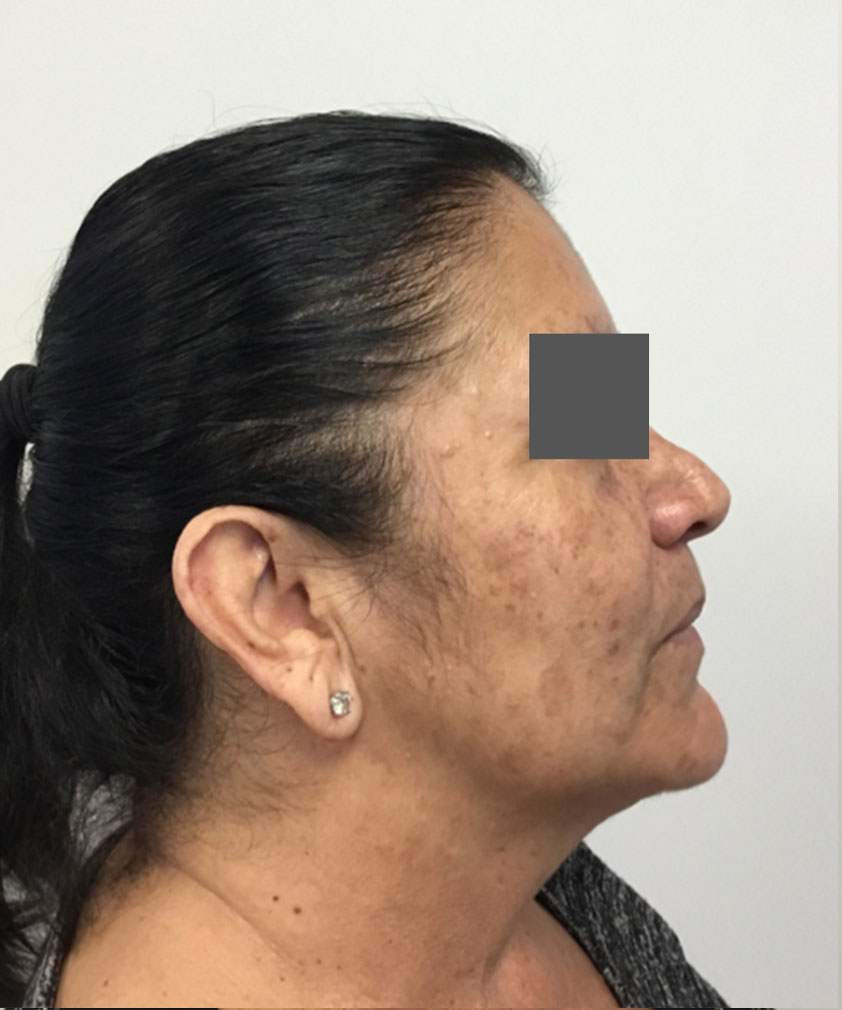

Actual Halcyon Patient
What is a Chemical Peel?
A peel is a procedure where a chemical solution is applied to remove the damaged outer layers of skin so that new, regenerated skin replaces the old. As a rule, the deeper the peel, the more profound the results, and the longer the recovery time.
What can be treated with Chemical Peels?
Acne, skin texture, mild to moderate wrinkles, sunspots, age spots, liver spots, freckles, and pigmentation can be improved with chemical peeling. The procedure can be performed on the face, neck, and hands. However, more severe wrinkles do not respond well to peeling and may require other kinds of cosmetic surgical procedures, such as a face lift, brow lift, laser, or soft tissue filler. Results of chemical peels are best seen with a series of treatments. Patients who are pregnant, nursing, have open wounds, or with allergies to the chemical peel ingredients may not undergo chemical peels.
Preparing for your peel:
- Schedule your peel at a time when you can avoid sun exposure for at least 48 hours. We advise our patients to wear a hat and sunscreen for 7-10 days after treatment.
- You may benefit from a lightening cream product for 1 month before chemical peeling. Do not use Retin-A/retinol, salicylic or glycolic containing products for 1 week prior to the procedure.
- Do not use a self-tanning cream, pore strips, or wax for 5 days prior to the peel or for 2 weeks after the peel.
- Remove all make-up and products on your face, including sunscreen, when you come in for your peel.
- You may need to take medications to prevent a cold-sore if you are prone to them.
What to expect after your peel:
Redness, swelling and skin sensitivity is possible for 2-3 days. Peeling can occur for 5 days or more. Peeling, blisters, swelling, and prolonged erythema can occur with these peels and can be treated with Biafine cream. If there is no peeling or flaking, it does not mean that the peel is not working. There are many factors that contribute to skin peeling, and not all patients will react the same. The results will not be compromised if you do not experience peeling. Daily use of SPF 40-50 is necessary throughout the peeling process.
Which peel is right for me?
We offer numerous different types of peels. We recommend a cosmetic consultation before your appointment to determine the best peel for you.
Aging skin:
Glycolic peels: These superficial to medium depth glycolic peels vary in strength from 30-70% are used to treat aging skin.
Neostrata Retinol Peel: A superficial 3% Retinol plus Retinol Boosting Complex™ to exfoliate and improve the appearance of fine lines and wrinkles, help reduce acne, and promote a bright, even and clear complexion. The peel is applied in-office and washed off at home after 8-12 hours.
Mandelic Peel: This is a very mild chemical peel that works very superficially. This is the ideal treatment for skin associated with redness and sensitivity and has minimal down time.
Neck Peel: This superficial-medium depth Pyruvic Acid, Lactic Acid, and Ferulic Acid peel is indicated to treat premature aging of the neck.
TCA Peel (25-40%): These peels can go from medium to deep depths and are more aggressive than any of the above peels. They are excellent for mild to moderate wrinkling.
Hyperpigmentation:
Jessner’s Peel: This medium depth Lactic Acid, Salicylic Acid, and Resorcinol peel for the face is used to treat mild-moderate hyperpigmentation.
Glycolic Peels: These superficial to medium depth glycolic peels vary in strength from 30-70% and are used to treat mild hyperpigmentation.
TCA Peels (25-40%): These peels can go from medium to deep depths and are more aggressive than any of the above peels. A series of TCA peels can improve moderate to advanced pigmentation.
Acne/Blemish Prone Skin:
Salicylic Acid Peel: Superficial depth peel to treat acne and fade acne blemishes for face and back.
What are the possible side effects of chemical peels?
It is possible to develop pigmentation or scarring with chemical peels, but by slowly stepping up the strength of the peel, this is generally avoided. Also, by avoiding the sun and by using a lighting cream before and possibly after the procedure this risk of pigmentation is decreased. If you have a history of “cold sores” around the mouth, we will prescribe a medication to decrease your risk of a breakout of a cold sore after the peel. It is also not uncommon to have an acne break out after the peel.
Post treatment instructions
- Do not apply water or make up to the treated area(s) for 5 hours after your peel. You may use Biafine cream immediately as needed for the next 24-72 hours for any skin discomfort, then use a daily moisturizer such as Cetaphil or CeraVe cream. Refrain from sun or heat exposure for a minimum of 48 hours.
- It is best to avoid direct sun exposure for 7 days after you peel. We advise wearing a hat and applying SPF every 2 hours when in direct sun to reduce your risk of developing hyperpigmentation, especially if you have a darker skin type.
- Do not initiate any new medications, cosmetics, or skin care products without prior approval from our staff.
- Peeling can occur within 48-72 hours, and you can cleanse your skin 2-3 times per day with Cetaphil or CeraVe gentle cleanser after 5 hours. Do not vigorously cleanse, scrub or rub your skin. Apply a moisturizer for sensitive skin after cleansing.
- You may benefit from a lightening cream such as Hydroquinone or Lytera before and after your peel. This should be applied after cleansing and before applying moisturizer and sunscreen.
